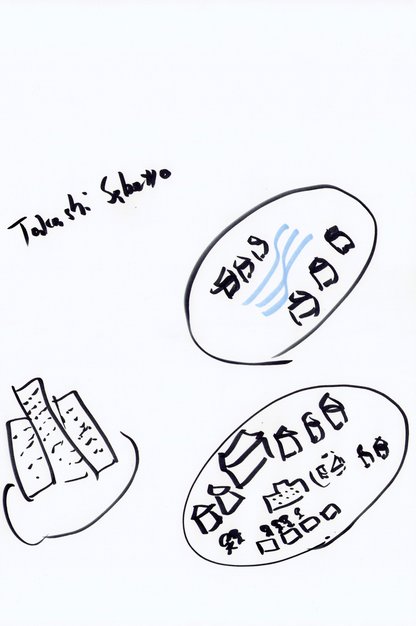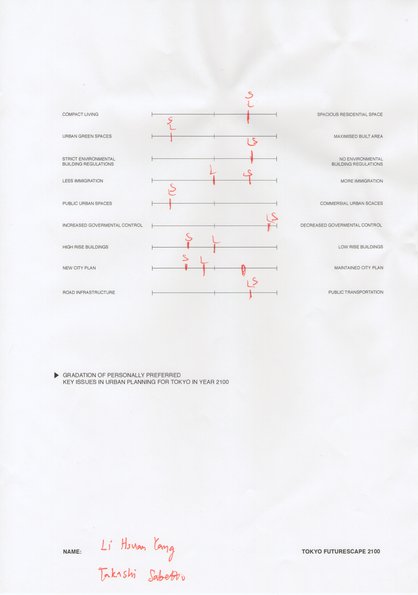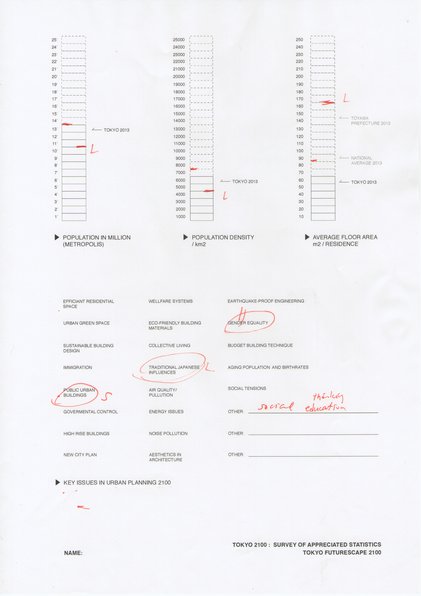Futurescape Tokyo is
a study in urban
fantasies and speculative
cartography. The project aims
to explore potential future
scenarios of the world's
largest megalopolis Tokyo,
which is expected to
shrink dramatically
during the next 86 years.
INTERVIEWS & MAPS
MIRAIE – HOUSE OF THE FUTURE
Living together with non-family members has been very unusual in Japan. However, in a society where less people marry or marry later in life, share housing has expanded rapidly in recent years. In a three-floor wooden house with a hot tub on the roof, young couple Takashi Sabetto and Li Hsuan Yang are trying out their own version of a future family life style. Together with their three year old daughter Eri, the long-term resident Wakaba, the puppy Joy and a couple of short term visitors, they are extending the boundaries of the family. Welcome to Miraie, the future house.
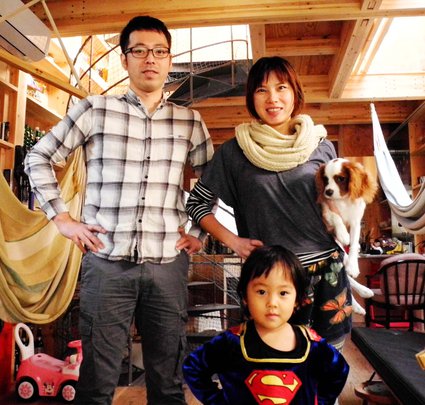
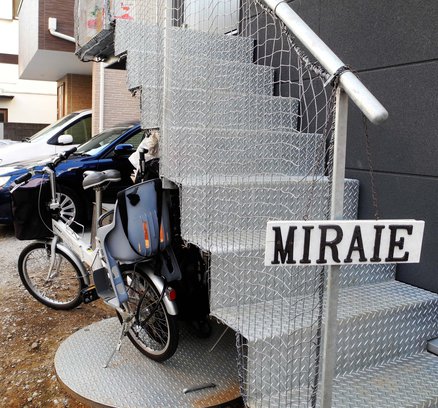
What does the name "Miraie" stand for?
Takashi: Miraie is Japanese for "The Future House". Most people in Tokyo live next to each other in tiny apartments – but they don't know each other at all. We try to create a different kind of lifestyle for ourselves, with a greater sense of community and more contact with other people.
How is life in Miraie, compared to a normal Japanese home?
Li: The big difference is that we are a family, but we also choose to live together with others. In most share houses there are only single people, while most families shut down to themselves. Here, the three of us live together with one long-term resident and a couple of short-term guests. And we all live here together like a family. That is quite a big difference from others, I think.
Takashi: We are very connected to each other in this house. When we sketched the layout of the house together with the architect, we decided to make the structure open and to link together the different parts of the building in a way that enables you to hear if the others are around, when they come or leave, or if someone is chilling out in the living room. But everyone also have their own private space.
Is it unusual for a Japanese family to invite strangers to their home?
Takashi: It is more common in the countryside than in Tokyo. In the villages families connect to each other and invite friends over all the time, they don't even bother locking the door. But in Tokyo it is not like that at all.
Li: When Wakaba, our long-term share-mate, first came to live with us, her mother did not approve of it. She found it odd that a young single woman would live together with a married couple and their baby. She was worried that Wakaba might disturb us and our daughter. However, after she came to visit us she changed her mind. She understood that there is enough space for different kinds of people here, with different habits and schedules. Our daughter has been living with other people since she was a baby, so she is used to it.
Takashi: I think this is a very good environment for kids. And I also think it is a good thing for adults, to live with kids. It is so easy to forget about the creativity and playfulness you once had as a child. Maybe living with kids can help you wake up that creativity and open-mindedness again.
Collective living and share houses seem to have become increasingly popular in Tokyo during recent years. Do you think this is due to a change of values in the Japanese society?
Li: I think so. I think young people are looking for something else, something more, in this city. So yes, I think there is a change. I don't know the percentage though, maybe it is just a small group. I don't think share housing is for everyone. Some people will still want to live by themselves in very tiny apartments, without ever connecting to other people.
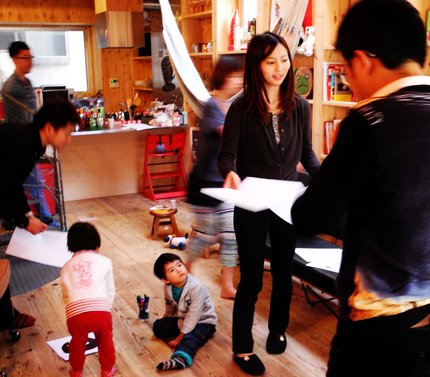

How would you describe Tokyo as a city today?
Takashi: The fascinating thing about Tokyo is that there are many cities in one. Every neighborhood differ from the others, with its own color, its own mindset. If you go to Harajuku, there is this specific Harajuku culture. Same thing in Shibuya. Tokyo is unique in this way.
Li: Maybe I have a different view than Takashi since I am from Taiwan. I am a foreigner here. But I think Tokyo is a very sad city. It is so lonely. The Tokyoites look fancy, but really, to me they seem so isolated and close-minded. That is how I feel about Tokyo right now, unfortunately.
Li, how would you describe life as an immigrant in Tokyo?
Li: I think it is hard to fit in and be accepted in Japan, even if you are just a tiny bit different. Maybe it is because I am a foreigner I feel so, but it feels like people are watching you all the time here. Even if I am just walking my dog, someone will tell me to not disturb others with the dog. But the dog is being just fine, not even barking or pooing on the street or anything! This is so weird to me, because it does not happen in my country. I will give you another example. The other day our next-door neighbor came to me and asked me to put up a curtain to cover the bath tub we have on the roof. Because their son felt he could not open the window when my daughter and I were having a bath. I mean, we are never naked up there or anything, it really is just a mother playing with her daughter in a pool. But they still feel that we are disturbing their life, just by sitting there.
Takashi, what are the main challenges for Tokyo according to you?
Takashi: I agree with Li, that Tokyo is quite close-minded. People don't want to interact with foreigners, they don't know how to do. Another problem is that the Tokyoites are way too individualistic, not caring about society and only thinking about their own space.
By 2100, the population of Tokyo is expected to have been cut in half. Do you think this dramatic population loss will really happen?
Li: I think it might happen. However, the Japanese will probably have found a way to solve the problem by then, they are very good at creating and developing new things. Maybe some new technology will help them create an ideal kind of life style, suitable for that society.
Takashi: I guess that if nothing changes, then the population will decline heavily as expected. On the other hand, maybe things will be completely different by year 2100. Maybe there is nothing called Japan anymore and nothing called Sweden. Africa might not be the only place in the world with high birth rates anymore. The world might be much more merged together, maybe there are no borders.
Do you think immigration can solve the problem of a shrinking population?
Li: It is possible. But for that to happen, Japan first needs to become much more open-minded. Otherwise immigrants won't come, and the Japanese will not let them in either. So this needs to be solved first. I think it would be a good thing if more immigrants came though. Maybe this is what the society needs to become more open and diverse.
By 2100 your daughter Eri will be nearly 90 years old. She will be one of the many elderly in Japan. 45 percent of the population are expected to be over 65 years old – the same percentage as the working population. How do you think this high percentage of elderly will affect the city?
Li: Maybe young people and elderly will live together in a higher degree. People may have to help each other more. Or maybe something completely different will emerge from this situation, something that we don't expect right now. Maybe it is a good thing.
Takashi: Maybe robots will be helping the elderly by year 2100.
Li: Maybe, but I would not like that. When I grow old, I would like to receive help in a natural way, from someone who is alive. A human being, or even a dog.
The triple catastrophe in Japan in 2011 was a forceful reminder of the geographical vulnerability that is a reality also for Tokyo. Do you think this has influenced the view people have on life in this city, in any way?
Takashi: Yes, I definitely think it made some people re-evaluate their view on what is important in life. The earthquake was not only a reminder of safety issues, but also of what values you choose in life. Before it happened, a lot of people thought that a successful life meant working hard and earning a lot of money in Tokyo. But after the catastrophe more young people have started to question that. They have realized that working and getting a good salary is not the only goal in life. Really, you should try to search for a life you are happy with. What you think is a good lifestyle for you. To be a human being and try to satisfy your own wishes. Some people have moved out from Tokyo to search for a different lifestyle in the countryside.
It is likely that Tokyo will suffer from another earhquake before year 2100, and the city will have to rebuild again. What do you think is important for a successful reconstruction?
Takashi: If a need for reconstruction occurs, I sure think that Tokyo should take the opportunity to change things. But it is a mistake to develop the city through huge money consuming projects like the Roppongi Hills. I think the best way to transform the city is by small scale grass root things. Such as this Miraie house for example.
TOKYO'S FUTURESCAPE ACCORDING TO LI AND TAKASHI
My vision of Tokyo in the future is inspired by the idea of the "Local Community Area" by Riken Yamamoto. Tokyo 2100 is divided into many small communities, with approximately 500 inhabitants in each unit. The communities are distinguished from each other according to their own special character. Some communities are urban, some are rural. The communities are separated politically and economically, but of course they interact with each other. They are all connected by train. Inside each of these units, there is a great sense of community. Instead of the nuclear family, the village is the main entity in the city planning. People organize life together and share flexible common spaces. The elderly and children have a natural place in this environment, where a broader network of people help and take care of each other. The houses are connected, like lego-blocks. The parts can be separated and put together in a new form, creating a diversity in lifestyles and household composition. Possibly, the Miraie house will grow into a town of 500 persons. I hope so.
Takashi Sabetto
In Tokyo 2100 there are less people and less buildings. It is very clean, green and beautiful. There are a lot of open spaces. Everything is very high tech and everyone are highly educated. Gender equality is not even an issue, since it is so well established. People live side by side, even though they come from different cultures. It is a very creative and flexible city, where nothing is really solid. The city has passed through a difficult time of many disasters, but they have now reached a great stage where people can live according to their own wishes. Everyone are free to live just as they feel like, but without harming or disturbing one another. There will be a great social consciousness and a great sense of community.
Li Hsuan Yang
